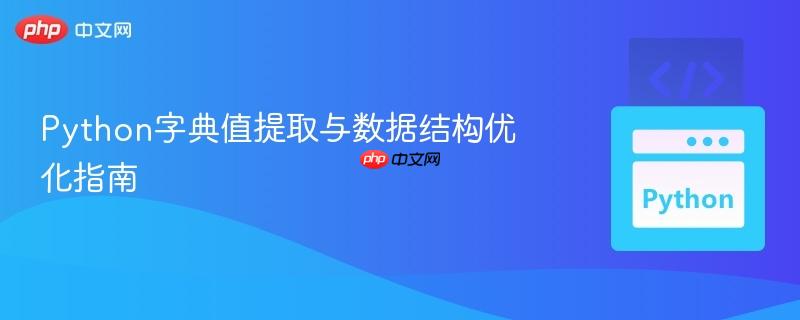
本教程旨在解决python初学者在处理字典数据结构时常遇到的问题,特别是当尝试将嵌套字典的值转换为列表时。文章将深入分析不当的数据结构设计如何阻碍有效的数据提取和后续处理(如排序),并提供一套优化的解决方案,通过简化字典结构来提升代码的清晰度、效率和功能性,确保开发者能够正确地获取并处理所需的数据。
在Python编程中,字典(Dictionary)是一种强大且灵活的数据结构,用于存储键值对。然而,不恰当的设计可能会导致数据提取和操作变得复杂。本文将通过一个实际案例,深入探讨如何优化字典的数据结构,以便更高效地管理和访问数据。
许多初学者在构建数据存储逻辑时,可能会无意中创建出过于复杂的嵌套结构。考虑以下场景:用户希望收集一系列生日信息,并将其存储在一个字典中,以便后续进行排序。原始代码可能采用了如下结构:
from datetime import datetime
dict_place = 1
birth_dict = {}
def date_key(date_string):
return datetime.strptime(date_string, "%d %b %Y")
while True:
name = input("Enter name of person: ")
birth_month = input("What month were they born?: ")
birth_day = input("What day of the month were they born?: ")
birth_year = input("what year were they born?: ")
birth_day = str(birth_day)
if len(birth_day) == 1:
birth_day = "0" + birth_day
birth_month = birth_month[0:3].capitalize()
birthdate = birth_day + " " + birth_month + " " + birth_year
# 核心问题所在:创建了不必要的嵌套
birth_dict[dict_place] = {name: birthdate}
dict_place += 1
new_date = input(
"Do you want to enter another birthday?\n\nY for yes N for no\n\n"
)
if new_date.lower() == "y":
continue
else:
break
x = birth_dict.values()
print(x)这段代码的意图是收集姓名和生日,并最终提取所有生日信息。然而,birth_dict[dict_place] = {name: birthdate} 这一行创建了一个形如 {1: {'Jon': '01 Jan 2000'}, 2: {'Jane': '02 Feb 2001'}} 的嵌套字典结构。在这种结构下,直接调用 birth_dict.values() 将返回 dict_values([{'Jon': '01 Jan 2000'}, {'Jane': '02 Feb 2001'}]),其中每个元素仍然是一个字典,而不是期望的生日字符串列表。这种不必要的嵌套使得直接获取所有生日字符串变得复杂。
解决上述问题的关键在于简化字典的结构。如果我们的目标是根据人名查找生日,那么将人名直接作为字典的键,生日作为对应的值,是最直观和高效的方式。这样可以避免不必要的中间层嵌套。
立即学习“Python免费学习笔记(深入)”;
推荐的字典结构应该是 {'Jon': '01 Jan 2000', 'Jane': '02 Feb 2001'}。
要实现这种结构,我们只需对代码进行以下修改:
经过优化后的代码如下所示:
from datetime import datetime
birth_dict = {} # 不再需要 dict_place
def date_key(date_string):
"""
将日期字符串转换为 datetime 对象,便于后续排序。
"""
try:
return datetime.strptime(date_string, "%d %b %Y")
except ValueError:
print(f"警告: 日期格式 '{date_string}' 无效,无法转换为日期对象。")
return None # 返回 None 或抛出异常,根据需求处理
while True:
name = input("请输入姓名: ")
birth_month = input("请输入出生月份: ")
birth_day = input("请输入出生日期: ")
birth_year = input("请输入出生年份: ")
# 格式化日期,确保月份缩写和日期补零
birth_day = str(birth_day).zfill(2) # 使用 zfill 更简洁地补零
birth_month = birth_month[0:3].capitalize()
birthdate_str = f"{birth_day} {birth_month} {birth_year}"
# 优化后的数据存储方式:姓名直接映射到生日字符串
birth_dict[name] = birthdate_str
new_entry = input(
"\n是否继续输入其他生日信息?\n\nY 表示是 N 表示否\n\n"
)
if new_entry.lower() == "y":
continue
else:
break
# 提取所有生日字符串
all_birthdates_str = list(birth_dict.values())
print("\n所有生日字符串:", all_birthdates_str)
# 进一步处理:将生日字符串转换为 datetime 对象列表并排序
# 过滤掉 date_key 转换失败的 None 值
sorted_birthdates = sorted(
[date_key(d) for d in all_birthdates_str if date_key(d) is not None]
)
print("按日期排序后的生日列表 (datetime 对象):", sorted_birthdates)
# 如果需要按姓名排序,可以使用 sorted(birth_dict.items())
sorted_by_name = sorted(birth_dict.items())
print("按姓名排序后的生日列表 (键值对):", sorted_by_name)选择合适的数据结构: 在开始编写代码之前,花时间思考数据的最佳表示方式至关重要。如果键是唯一的标识符,并且需要快速查找对应的值,那么字典是理想的选择。如果需要保持元素的插入顺序或通过索引访问,列表可能更合适。
直接存储 datetime 对象: 在上述示例中,生日被存储为字符串。然而,如果主要目的是对日期进行操作(如排序、计算年龄),那么直接将 datetime.datetime 对象存储为字典的值会更有效率,避免重复的字符串解析。
# 修改后的存储方式,直接存储 datetime 对象
from datetime import datetime
birth_dict_dt = {}
while True:
name = input("请输入姓名: ")
birth_month = input("请输入出生月份: ")
birth_day = input("请输入出生日期: ")
birth_year = input("请输入出生年份: ")
birth_day = str(birth_day).zfill(2)
birth_month = birth_month[0:3].capitalize()
birthdate_str = f"{birth_day} {birth_month} {birth_year}"
try:
birth_dict_dt[name] = datetime.strptime(birthdate_str, "%d %b %Y")
except ValueError:
print(f"日期格式错误:{birthdate_str},请重新输入。")
continue # 允许用户重新输入
new_entry = input("\n是否继续输入其他生日信息?(Y/N)\n\n")
if new_entry.lower() == "y":
continue
else:
break
# 直接提取并排序 datetime 对象
sorted_birthdates_dt = sorted(birth_dict_dt.values())
print("\n按日期排序后的生日列表 (datetime 对象):", sorted_birthdates_dt)处理重复键: 如果存在同名的人,而你仍然想用姓名作为键,那么一个字典将无法存储所有信息(因为键必须唯一)。在这种情况下,可以考虑使用一个列表来存储多个字典,例如 [{'name': 'Jon', 'birthdate': '...'}, {'name': 'Jon', 'birthdate': '...'}]。
输入验证: 实际应用中,用户输入可能不符合预期格式(例如,输入非数字的日期)。添加 try-except 块来捕获 ValueError 等异常,可以增强程序的健壮性。
正确选择和设计数据结构是编写高效、可维护Python代码的基础。通过避免不必要的嵌套,我们可以简化数据访问逻辑,提高代码的可读性和性能。在处理字典时,始终考虑键值对的最直接映射,并根据实际需求存储最合适的数据类型(例如,直接存储 datetime 对象而非日期字符串),这将大大简化后续的数据处理任务。
以上就是Python字典值提取与数据结构优化指南的详细内容,更多请关注php中文网其它相关文章!

每个人都需要一台速度更快、更稳定的 PC。随着时间的推移,垃圾文件、旧注册表数据和不必要的后台进程会占用资源并降低性能。幸运的是,许多工具可以让 Windows 保持平稳运行。

Copyright 2014-2025 https://www.php.cn/ All Rights Reserved | php.cn | 湘ICP备2023035733号